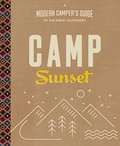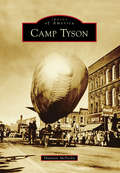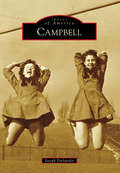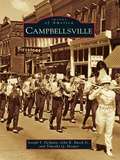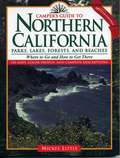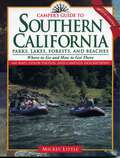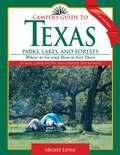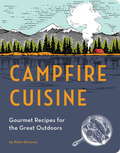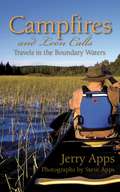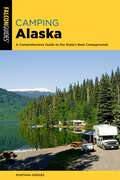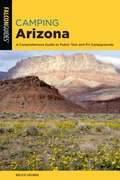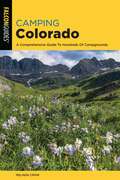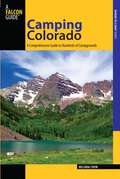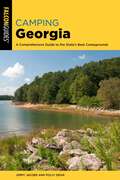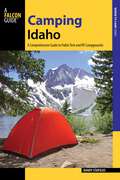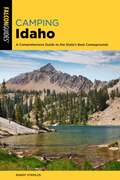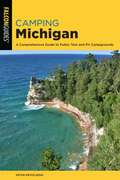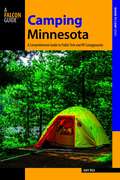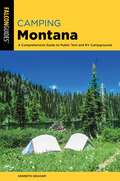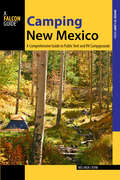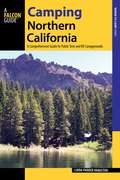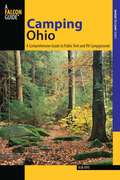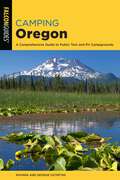- Table View
- List View
Camp Sunset: A Modern Camper's Guide to the Great Outdoors
by Editors of Sunset Elaine Johnson Matt JaffePlan your next adventure with this complete guide to exploring nature, campfire cooking, and sleeping under the stars. The experts at Sunset draw on more than a century of outdoor experience to create a guide that leaves no stone unturned. Easy to navigate and chock full of clear how-to's, handy checklists, lush photographs, and a nifty pull-out glow-in-the-dark constellation map, Camp Sunset offers something for everyone.You'll find essential advice on choosing the right gear, setting up camp, and dealing with local critters, alongside Sunset's best tips for an unforgettable trip. Learn to whip up a flawless camp stove meal, mix a cocktail to match, and stargaze like a pro. Discover hands-on activities for campers of all ages, plus special features on photographing nature, foraging, and telling campfire stories. Upgrade your outdoor skills with Sunset's proven strategies, then stash this book in your bag, and get ready to explore! Useful on the trail and inspiring in the off-season, Camp Sunset is the ultimate handbook for having more fun outdoors.
Camp Tyson: The Story Of Camp Tyson - America's Only Barrage Balloon Training Facility (Images of America)
by Shannon McfarlinIn 1941, Paris, Tennessee, became the home of Camp Tyson. The 2,000-acre camp named for Knoxville World War I veteran Brig. Gen. Lawrence Tyson was built by some 800 laborers and consisted of 450 buildings including barracks, a hospital, and a theater. Over the course of World War II, the camp grew to about 6,000 acres in size and served as a training ground for as many as 25,000 servicemen, as well as a POW camp for many Germans and Italian prisoners. At Camp Tyson, soldiers trained to construct, maintain, and operate barrage balloons. These balloons were successfully used to provide anti-aircraft protection during World War I and again in World War II with the help of those trained in Henry County. However, the atomic bomb made barrage balloons obsolete, and after the war, Camp Tyson was decommissioned.
Campbell (Images of America)
by Joseph PavlanskyShaped from the rough farmlands and hills of northeast Ohio and forged from the blood, sweat, and tears of the steel mill workers, the city of Campbell (formerly Coitsville Township and later East Youngstown) had a humble start. With the turn of the 20th century, it was thrust into an economic growth that rivaled the biggest cities in the United States. Measuring only 3.74 square miles, some said Campbell brought in enough revenue that the streets could be lined with gold. The Youngstown Sheet & Tube Company Campbell Works formed in 1900 and brought with it the need for more workers. As immigrants from the surrounding areas came for employment, their families joined them from Europe. Within a few years, Campbell became a culturally diverse city that fed on the revenue from the steel mill and its socioeconomic by-products.
Campbellsville (Images of America)
by Timothy Q. Hooper John R. Burch Jr. Joseph Y. DespainTaylor County became the 100th county in the commonwealth of Kentucky when it was created on March 1, 1848. The county was named after Zachary Taylor, who gained fame as a general in the Mexican War and eventually became president of the United States. The town of Campbellsville, founded in 1817, was selected to serve as the county's seat of government. Throughout its history, the growth of Campbellsville and Taylor County has been marked by both boom periods and years of severe trials and tribulations. Despite the difficulties faced by the residents of Taylor County, its citizens have always shown admirable grit and determination in improving the circumstances of their families and community. Today the county features a diversified economic base that serves a population of 24,069. Of that number, 11,010 reside within Campbellsville's borders.
Camper's Guide to Northern California: Parks, Lakes, Forests, and Beaches
by Mickey LittleFeaturing key campground features, facilities, and activities, this guide's 130+ maps take you right where you want to go. This is the most complete, map-packed, best-organized camping guide you can own.
Camper's Guide to Southern California: Parks, Lakes, Forest, and Beaches
by Mickey LittleBetter than dry matches on a rainy night, this new edition locates and describes hundreds of marvelous camping opportunities and recreational activities. Featuring key campground eatures, facilities, and activities, this guide's 160 + maps take you right where you want to go. This edition is packed with maps and information on 87 state and national parks, lakes, beaches, forests, and recreation areas.
Camper's Guide to Texas Parks, Lakes, and Forests: Where to Go and How to Get There
by Mickey LittleA practical guide from an expert camper who rates campsites throughout Texas including location, facilities, activities, sights, layout, fees and cautions. Photos give the flavor and attractions of many of the sites.
Campfire Cuisine
by Robin DonovanFinally, here's a guide for people who love good food and the great outdoors. Campfire Cuisine provides more than 100 recipes for delicious, healthy, satisfying meals to make at your campsite or in any outdoor setting. Also included are tips on meal planning, shopping, and choosing the right equipment. Armed with Campfire Cuisine everyone from die-hard foodies to novice cooks will be ready to take on eating well while camping out.
Campfires and Loon Calls
by Jerry Apps Steve AppsDuring his twenty-five years of canoeing in the wild, Jerry Apps has experienced it all-wicked thunderstorms, inquisitive bears, swamping a canoe, night skies filled with more stars than imaginable, falling asleep to the lullaby of water lapping at the water's edge.In his latest book, Campfires and Loon Calls, Apps generously shares his seasoned advice, from how to set up camp and protect food from hungry bears to minimalist cooking and appreciating a rainy day, all the while weaving in the incredible history of the Boundary Waters region.Through beautiful prose and photos from award-winning photographer Steve Apps, Jerry also reflects on how the Boundary Waters is a place to connect with nature.Jerry Apps writes novels and nonfiction books about the outdoors, country life, and rural living. He received the 2008 First Place Nature Writing Award from the Midwest Independent Publishers Association and the 2007 Major Achievement Award from the Council for Wisconsin Writers. He and his wife live in Madison, Wisconsin.Steve Apps is an award-winning photojournalist with twenty-five years in the newspaper industry. As a Wisconsin State Journal staff photographer he has covered a wide range of assignments, including the Green Bay Packers and University of Wisconsin-Madison sports.
Camping Alaska: A Comprehensive Guide to the State's Best Campgrounds
by Montana HodgesCamping Alaskaprovides everything you need to know to camp across the state, including campsites managed by state and county parks, the USDA Forest Service, and the US Army Corps of Engineers. This comprehensive guidebook will take you to the ideal spot to pitch your tent or park your RV.
Camping Arizona: A Comprehensive Guide to Public Tent and RV Campgrounds
by Bruce GrubbsLooking for the ideal spot to pitch your tent or park your RV? Let Camping Arizona take you there.This fully updated and revised comprehensive guidebook gives detailed descriptions of more than 150 public campgrounds throughout Arizona. These are campsites managed by national, state, city, and county parks; the USDA Forest Service; the Bureau of Land Management; tribal organizations; and several private companies. They're in remote wilderness areas and near cities, in deserts and on mountaintops, along raging rivers and by popular lakes.Easy-to-use maps and charts will help you choose the perfect site for your next camping trip, whether you're going alone, as a family, or with a group. You'll also find vital information on:·Campground locations·Facilities and hookups·Fees and reservations·Recreational activities·GPS coordinates for each campground
Camping Colorado: A Comprehensive Guide to Hundreds of Campgrounds (State Camping Series)
by Melinda CrowCamping Colorado will take you to the ideal spot to pitch your tent or park your RV. This comprehensive guidebook gives detailed descriptions of more than 300 campgrounds statewide, including campsites managed by national, state, city, and county parks; the Forest Service; the Bureau of Land Management; and the US Army Corps of Engineers. Easy-to-use maps and charts will simplify your search for the perfect campground. You&’ll also find vital information on camp locations, fees and reservations, facilities and hookups, recreational activities, weather and geography, and local attractions. Camping Colorado provides useful tips on camping etiquette, camping with children, and enjoying—or avoiding—the state&’s diverse and abundant wildlife.Look inside to find:Campground locationsFacilities and hookupsFees and reservations GPS coordinates for each campground Tips on wildlife, safety, and zero-impact camping
Camping Colorado: A Comprehensive Guide to Hundreds of Campgrounds (State Camping Series)
by Melinda CrowCamping Colorado will take you to the ideal spot to pitch your tent or park your RV. This comprehensive guidebook gives detailed descriptions of more than 300 campgrounds statewide, including campsites managed by national, state, city, and county parks; the Forest Service; the Bureau of Land Management; and the US Army Corps of Engineers.Easy-to-use maps and charts will simplify your search for the perfect campground. You&’ll also find vital information on camp locations, fees and reservations, facilities and hookups, recreational activities, weather and geography, and local attractions. Camping Colorado provides useful tips on camping etiquette, camping with children, and enjoying—or avoiding—the state&’s diverse and abundant wildlife. Look inside to find:Campground locationsFacilities and hookupsFees and reservations GPS coordinates for each campground Tips on wildlife, safety, and zero-impact camping
Camping Florida: A Comprehensive Guide To Hundreds Of Campgrounds
by Rick SappFlorida hosts some six million campers annually, and many of them stay at the state&’s public campgrounds and campsites—for reliability, affordability, and their beautiful locations in remote nooks and crannies of the state. This revised edition of Camping Florida is the most comprehensive guide available to the Sunshine State&’s public campgrounds and campsites. Nearly exhaustive in scope, this guide covers everything from primitive sites to developed ones; and from youth and group sites to teepees, yurts, and cabins for individuals, friends, and families.
Camping Georgia: A Comprehensive Guide to the State's Best Campgrounds (State Camping Series)
by Jimmy Jacobs Polly DeanLooking for the ideal spot to pitch your tent or park your RV? Camping Georgia will take you there. This comprehensive guidebook gives detailed descriptions of more than 100 public campgrounds throughout Georgia – from the mountains to the plains to the coastal areas. The listings include campsites managed by national, state, city, and county parks, the Forest Service, the Bureau of Land Management, and the U.S. Army Corps of Engineers. Easy-to-use maps and charts will simplify your search for the perfect campground. You'll also find vital information on camp locations, fees and reservations, facilities and hookups, recreational activities, weather and geography, and local attractions.
Camping Idaho: A Comprehensive Guide to Public Tent and RV Campgrounds
by Randy StapilusLooking for the ideal spot to pitch your tent or park your RV? Camping Idaho will take you there.This comprehensive guidebook gives detailed descriptions of more than 300 public campgrounds throughout Idaho's widely varied scenery. These are campsites managed by national, state, city, and county parks; the Forest Service, the Bureau of Land Management; and the Idaho Power Company. They're in the remote wilderness areas and near cities, in deserts and on mountaintops, along roaring streams and by popular fishing and boating lakes.Easy-to-use maps and charts will help you choose the perfect site for your next camping trip, whether you're going alone, with your family, or as part of a group. You'll also find vital information on campground elevations, facilities and hookups, fees and reservations, recreational activities, and zero-impact camping.Whether you want to fish, hunt, or just get away from it all, let this book be your guide.
Camping Idaho: A Comprehensive Guide to the State's Best Campgrounds
by Randy StapilusLooking for the ideal spot to pitch your tent or park your RV? Camping Idaho will take you there.This comprehensive guidebook gives detailed descriptions of more than 300 public campgrounds throughout Idaho's widely varied scenery. These are campsites managed by national, state, city, and county parks; the Forest Service, the Bureau of Land Management, and the Idaho Power Company. They're in remote wilderness areas and near cities, in deserts and on mountaintops, along roaring streams and by popular fishing and boating lakes.Easy-to-use maps and charts will help you choose the perfect site for your next camping trip, whether you're going alone, with your family, or as part of a group. You'll also find vital information on campground elevations, facilities and hookups, fees and reservations, recreational activities, and zero-impact camping.Whether you want to fish, hike, or just get away from it all, let this book be your guide.
Camping Michigan: A Comprehensive Guide To Public Tent And RV Campgrounds (State Camping Series)
by Kevin RevolinskiNo other campground guidebook focuses solely on the Michigan quite like Kevin Revolinski's. Michigan offers a surprising array of quiet, out-of-the-way parks replete with lakes, rivers, rugged hills, and even rocky cliffs. Fully revised and updated, Camping Michigan opens the door to these places. It includes:Ø Up-to-date trail information and route descriptionsØ Accurate directions to popular as well as less-traveled trailsØ Difficulty ratings for each hikeØ Historical highlightsØ Detailed trail mapsØ Zero-impact camping, and wilderness safety tips and techniques
Camping Minnesota: A Comprehensive Guide to Public Tent and RV Campgrounds (State Camping Series)
by Amy ReaCamping Minnesota contains comprehensive descriptions of public tent & RV campgrounds throughout the Gopher State. This guide includes information on campground locations, facilities and hookups, fees and reservations, recreational activities, and Leave No Trace camping.
Camping Montana: A Comprehensive Guide to Public Tent and RV Campgrounds (State Camping Series)
by Kenneth L. GrahamThe classic guide to Montana's gorgeous campgrounds, now completely updated and revised!Camping Montana details nearly 300 public campgrounds accessible by vehicle--from Kalispell to Miles City and everywhere in between. Outdoor enthusiasts are sure to find the perfect spot in which to kick back and enjoy the sights, smells, and sounds of Montana.
Camping New Mexico: A Comprehensive Guide to Public Tent and RV Campgrounds (State Camping Series)
by Melinda CrowLet your trip to the Land of Enchantment begin with Camping New Mexico. Fully updated and revised with more than 150 public campgrounds, Camping New Mexico is an ideal companion for tourists and locals alike. Maps and quick reference tables are keyed to each area to help you pick a site that will meet all of your needs. You will also find many fun and exciting things to do in the surrounding areas of each campground. Whether you&’re planning to explore Carlsbad Caverns, test your rock climbing skills at City of Rocks State Park, or hike in the Manzano Mountains, Camping New Mexico can help you find the perfect spot to pitch your tent or park your RV.Look inside for:Campground locationsDetailed mapsGPS coordinates for each campground Driving directionsFacilities and hookupsDates of operationFees and reservations Recreational activitiesWhat equipment and clothing to bringTips on wildlife and safety
Camping New Mexico: A Comprehensive Guide to Public Tent and RV Campgrounds (State Camping Series)
by Melinda CrowLet your trip to the Land of Enchantment begin with Camping New Mexico. Fully updated and revised with more than 150 public campgrounds, Camping New Mexico is an ideal companion for tourists and locals alike. Maps and quick reference tables are keyed to each area to help you pick a site that will meet all of your needs. You will also find many fun and exciting things to do in the surrounding areas of each campground. Whether you&’re planning to explore Carlsbad Caverns, test your rock climbing skills at City of Rocks State Park, or hike in the Manzano Mountains, Camping New Mexico can help you find the perfect spot to pitch your tent or park your RV.Look inside for:Campground locationsDetailed mapsGPS coordinates for each campground Driving directionsFacilities and hookupsDates of operationFees and reservations Recreational activitiesWhat equipment and clothing to bringTips on wildlife and safety
Camping Northern California: A Comprehensive Guide to Public Tent and RV Campgrounds (State Camping Series)
by Linda HamiltonWith its diverse landscape, mild climate, and magnificent scenery, California is truly the Golden State for outdoor enthusiasts. Camping Northern California will guide you to the ideal spot to pitch your tent or park your RV while enjoying the myriad recreational opportunities the northern half of the stare has to offer. Featured here are hundreds of campgrounds accessible by car and managed by public agencies--everything from primitive sites for tents and self-contained RV's to plush resorts with spas, pools tennis courts, and even golf courses. Whether you're headed for the redwood forests, the High Sierra, or the San Francisco Bay area, let this book guide you to the perfect homes away from home.
Camping Ohio: A Comprehensive Guide to Public Tent and RV Campgrounds (State Camping Series)
by Bob FryeNo other campground guidebook focuses solely on the Prairie State. Ohio offers a surprising array of quiet, out-of-the-way parks replete with lakes, rivers, rugged hills, and even rocky cliffs. Camping Ohio opens the door to these places. It includes:Ø Up-to-date trail information and route descriptionsØ Accurate directions to popular as well as less-traveled trailsØ Difficulty ratings for each hikeØ Historical highlightsØ Detailed trail mapsØ Zero-impact camping, and wilderness safety tips and techniques
Camping Oregon: A Comprehensive Guide to Public Tent and RV Campgrounds (State Camping Series)
by Rhonda and OstertagLooking for the ideal spot to pitch your tent or park your RV? Fully revised and updated, Camping Oregon contains comprehensive descriptions of more than 600 public campgrounds throughout the Beaver State. Look inside for information on campground locations, facilities and hookups, fees and reservations, recreational activities, and zero-impact camping.Featuring:Campgrounds for every tasteCamping options for individuals, families, and groupsEasy-to-use maps and charts to help you choose the perfect site
